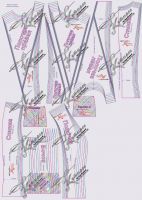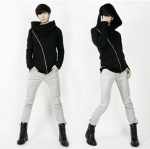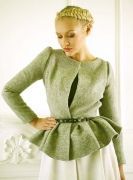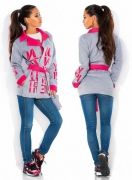Size charts What is the height of the pattern Payment methods Ask a question Reviews
How to sew with your own hands a women's jacket fitted on an oblique fastener according to a finished pattern
Contents of the instruction:
1. Description and complete set of patterns for sewing a jacket with your own hands.
3. Description of the design of the style of the jacket.
4. What to sew a jacket and fabric consumption.
5. How to download and print jacket patterns.
6. How to cut a jacket-leather jacket with your own hands according to the finished pattern.
7. How to sew a fitted jacket with your own hands step by step.
Description and configuration of patterns for sewing a jacket with your own hands
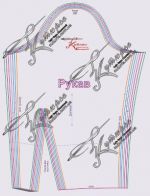 Electronic pattern of a female fitted jacket on an oblique fastener 40-64
Electronic pattern of a female fitted jacket on an oblique fastener 40-64
Sizes: 40-52 and 52-64 - the buyer receives ALL sizes of the selected gradation.
File format for download in order:
PDF in full size and without seam allowances.
After paying for the order, you will receive links to download two files jacket patterns of the selected size gradation:
- PDF A4 file adapted for printing patterns on sheets of A4 paper in any program on any device, including mobile phones.
- Multi-format PDF file for printing on sheets of any size from A0 to A4 on a printer or plotter using Adobe Reader.
Sewing difficulty level: medium. Suitable for most types of figures of various fullness (except for the "apple").
The pattern is designed for sewing at home on household sewing machines.
Complete set of patterns for a fitted jacket with an oblique fastener
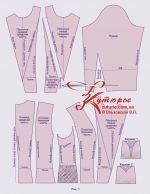 (picture 1):
(picture 1):
- Back patterns - middle and side parts.
- Shelf patterns - middle parts (left shelves - whole and cut, right shelf).
- Barrel pattern.
- Sleeve pattern.
- Pocket patterns.
The cuff-turning pattern for the sleeve is not included in the kit, as it is a strip. The stitching of the sprout is cut out along the middle part of the back (picture 2) and is also not included. The pick-ups are cut out along the middle parts of the shelf.
Please note that the set includes mirror parts of the shelf. This is done in order to reduce the number of misalignment errors of unpaired parts and assembly errors.
Description of the design of the jacket
 Fitted pattern jacket with slanting closure even with a stretch, it cannot be called easy for sewing with your own hands, so it is not recommended for beginner couturiers.
Fitted pattern jacket with slanting closure even with a stretch, it cannot be called easy for sewing with your own hands, so it is not recommended for beginner couturiers.
The tailor will need the ability to accurately assemble a product with zippers and the ability to try on.
The sewing option for this button-down jacket looks somewhat simpler - it is recommended for less experienced home couturiers. In this case, the uncut left shelf is used for cutting.
The design lacks the side seam we are used to, but it is replaced by two reliefs marked with a “two”. Additional reliefs of a back and shelves give the chance of more exact adjustment of a jacket on a figure.
In addition, a pocket is “based” on the details of the barrel – its edges coincide with the “second” relief. There are two pockets in the set of patterns: the first for processing with a zipper, the second for processing with a facing.
The sleeve of the jacket has a traditional but slightly reduced fit (this was done at the request of the buyers). Below we will consider how easy it is to increase or decrease the length of the okat according to the need that arises after trying on or at the request of the couturier.
The elbow tuck allows not only to easily adjust the width of the sleeve, but also to cut it out with all kinds of slots or, by drawing a line upwards from the top of the tuck, to get a sleeve from two fragments.
What to sew a jacket and fabric consumption
 Thick denim without elastane and plaid is ideal.
Thick denim without elastane and plaid is ideal.
Of course, it is also worth considering dress and suit wool, loden and tweed.
When choosing companion fabrics, consider the similarity of the compositions. You should not combine wool and synthetics, but if both fabrics are wool with a small addition of synthetics or both synthetics with a small addition of wool, these are the best options for compatibility in terms of quality composition.
The consumption of fabric for a jacket with a width of 140 cm will be from 120 to 200 cm, depending on the size and whether the selection will be cut out from the same fabric or from a companion fabric.
Companion fabric consumption - 60 - 80 cm. Dublerin consumption depends on its width, but in most cases, the same 60 - 80 cm will be needed.
Lining fabric about 120 cm, of course, if the jacket is planned to be lined.
How to download and print jacket patterns
How to choose a size without using tables and taking measurements.
How to buy a ready-made electronic pattern.
How to print a pattern at home in full size on A4 sheets or on sheets of any other format.
How to assemble a pattern after printing.
Ready-made patterns of dresses in full size download for free.
Buy and download this jacket pattern
How to cut a jacket-leather jacket with your own hands according to the finished pattern
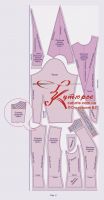 The recommendations for cutting this jacket do not differ from the usual ones for cutting for individual tailoring - it is better to cut it in two stages (picture 2).
The recommendations for cutting this jacket do not differ from the usual ones for cutting for individual tailoring - it is better to cut it in two stages (picture 2).
- First, everything you need to prepare the first fitting.
- Then everything you need to complete the sewing.
To prepare the first fitting, we need the details of the back, shelves and barrels. The middle shelf details can be duplicated, so we cut out the dubbing details for them using the same patterns and without seam allowances.
We can only mark the sleeves, pockets and facings on the fabric and postpone their cutting in order to cut them out after the fitting and armhole correction.
If the left middle part of the shelf is cut for a zipper, then cutting will require more attention from you than if this part is solid (for buttons or a false zipper).
On the 2 drawing details are highlighted that can be cut out in a single copy if the selection is made from a companion fabric.
Now about why it is desirable to cut out the sleeves after trying on. Because during the fitting, the length of the armhole may change. A change in the length of the armhole can occur due to the correction of the fit of the jacket along the relief seams, as well as due to the correction of the armhole itself.
Changing the length of the eyelet and the size of the fit of the sleeve often introduces novice couturiers into a stupor, while professionals choose the sleeve in width.
However, if you want to change the length of the hem, you can simply add a 1 cm allowance along the rim and / or expand the sleeve by 1 - 1,5 cm at the front and back seam. You can also cut off the hem by 1 cm and / or narrow the sleeve along the front and back seams. You can even choose a different size.
Now about the standard seam allowances, which should be done without taking into account any changes in the patterns.
We add 1 - 1,2 cm to most sections, depending on the flowability of the material.
WE DO NOT ADD allowances - to the cuts of armholes, collar, neck and sprout (back neck).
Along the edge of the board, you can add 0,3 - 0,5 cm or not add.
On the bottom - 2,5 - 3 cm. On the bottom of the sleeve - depending on the variation of the style.
You can cut out the elbow tuck of the sleeve or leave an allowance - "house" - it depends on the plasticity of the fabric and on your idea.
The facing of the sprout is cut out according to the pattern of the middle part of the back of the dublerin after trying on. After sticking to the fabric, the necessary allowances are added.
Facing for processing the bottom of the sleeve - after fitting with the sleeve and correcting its width and length. This is an oblique strip of fabric.
Pay attention to the allowances for the selection, which should be cut out according to the pattern of the middle part of the shelf. Take-off cut corresponding to the relief - without allowances. Otherwise, the allowances are the same as in the details of the side, BUT if there is a piping from the selection, then along the edge of the side and the neck, the allowances increase by 0,3 - 0,5 cm, depending on the thickness of the fabric.
It is easier to make a pocket double and, if the fabric is thick enough, then turn it with lining fabric.
After cutting, do not forget to transfer the half-skid lines to the middle parts - the shelves. Let me remind you that they must be preserved until the product is ready.
Don't forget to also put the notches marked on the drawings in the pattern file.
How to sew a fitted jacket with your own hands step by step
- Assembling the jacket for the first fitting - we duplicate the middle parts of the shelves, sweep (manually, if there is a line for sweeping on a typewriter, then by machine), slightly iron the seams.
- We make a shoulder pad, if it is provided, and attach it to the shoulder seam.
- The first fitting - fitting correction, armhole correction.
- Pocket processing, jacket assembly. Sections can be rounded or overcast. WTO (moist heat treatment) - after each operation.
- Cutting and processing of bands and necks. The pick-ups are duplicated, connected to the facing, then there is turning, edging, fastening.
- Cutting and assembling sleeves.
- Vetting sleeves, preparing for the second fitting.
- The second fitting is to clarify the length and width of the sleeves.
- Processing of sleeves and armholes.
- Processing the bottom - duplicate, overcast, sweep, hem.
- Loops and buttons, unless a zipper is provided.
- Finishing ironing.
Download this pattern pdf:
Pattern of a female fitted jacket on an oblique clasp
$2.50 (100 hryvnia)
Bank cards of the Russian Federation are not accepted for payment!
Size charts What is the height of the pattern Payment methods Ask a question Reviews
Vera Olkhovskaya in social networks:

See similar clothing patterns and how to sew on them
-
Any pattern for free for a review of a previously made order
More...
Lifetime promotion for buyers of patterns!

Leave a review about my store of patterns for an order that you made before, and you will receive any paid pattern of your choice Free!

